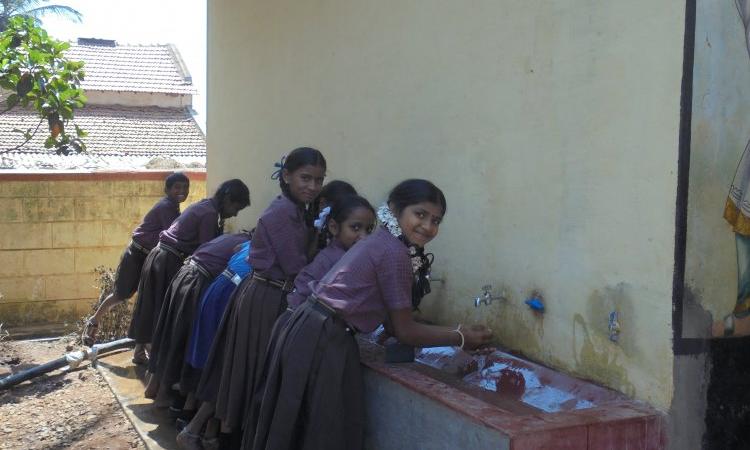
While the WatSan sector has been prioritised in the country’s policy agenda through the launch of the Swachh Bharat Mission, last year’s budgetary outlay was way below desired levels. The Ministry of Finance had organised a pre-budget consultation with the social sector organisations on 12th January 2016. WaterAid was one of the social sector organisations that was invited to make a submission to the Ministry. In its submission WaterAid India set down the budget asks for the WatSan sector and flagged issues emerging from the ground.
The National Rural Drinking Water Program (NRDWP) and Swachh Bharat Mission (SBM) are the two flagship programmes of the Government of India for rural drinking water and sanitation respectively. In the urban context, the Atal Mission for Rejuvenation and Urban Transformation (AMRUT) earlier called Jawaharlal Nehru National Urban Renewal Mission (JNNURM), is the national flagship programme driving capital investments in water supply, and the Swachh Bharat Mission (Urban) in the sanitation sector across India while pushing for governance reforms by urban local bodies and state governments.
Water and sanitation at the core of Sustainable Development Goals
The Union Budget needs to factor in the emerging realities in view of the changing Water Sanitation and Hygiene (WASH) context, given India’s international commitments. In September 2015, countries adopted the 2030 Agenda for Sustainable Development to end poverty and promote prosperity for all, while protecting the environment and addressing climate change. The new 2030 Agenda has water and sanitation at its core with a dedicated Sustainable Development Goal (SDG) 6 on water and sanitation with clear links to other goals. Adequate and appropriate budgets are necessary to ensure that Goal 6 of the SDGs is achieved.
Drinking water sector needs a fillip
Due to the strong efforts of the Union government, the SBM has been prioritised by the line ministries and departments. But, in the comprehensive effort in favor of sanitation, the focus has dwindled from drinking water as can be seen from the allocation for the National Rural Drinking Water Programme both at the Union and States level (Rs. 2,611 crore in 2015-16 as compared to Rs. 11000 crore in 2014-15). A Parliamentary Standing Committee Report on Water and Sanitation too has pointed out the fall-out of the decrease in drinking water allocation.
Establish regulations for Swachh Bharat Kosh
Donations of more than Rs. 349 crore have been made to the Swachh Bharat Kosh (Clean India Fund) by different organisations and people in 2014-2015. This is likely to increase manifold with the ever-increasing emphasis on the Clean India Campaign. In addition, a 0.5 percent Swachh Bharat Cess is being imposed from November 15, 2015 on all services liable for service tax. With more and more corporate resources being brought into the sanitation sector apart from the collection of the Cess, it is absolutely necessary to establish regulations of accountability and transparency.
A targeted approach needs to be applied to ensure that the money is utilised for the most vulnerable and the excluded in rural areas. The release of subsidy should be made as an entitlement to people. The World Bank too has committed $1.5 billion to support the Government of India implement the rural component of the SBM, and the program is focused on performance based incentives. A clear and transparent mechanism for monitoring its utilisation is needed. Along with provisioning of budgets, it is important to have robust monitoring systems to ensure effective use of the resources so it reaches where it should.
Per cent gap between proposed and allocated budget
Need adequate budget to address water and sanitation crisis in urban India
Under the SBM (Urban), the government in 2015-16 proposed to construct 1.04 crore household toilets, 2.5 lakh community toilets, 2.6 lakh public toilets, and solid waste management facilities in 4,041 towns. The government through Ministry of Urban Development had estimated a cost of Rs. 62,009 crore of which the proposed central assistance will be Rs. 14,623 crore. Adequate budgets are needed to address the water and sanitation crisis in urban India with necessary transparency and accountability mechanisms.
SBM (Urban) has the objective of making 1.04 crore individual household latrines in urban areas with unit cost of Rs. 4000 per toilet, which is much lower than rural individual household latrines. As the material costs are higher in urban areas, the amount is far from adequate. States like Tamil Nadu and Chhattisgarh are allocating a much higher unit cost with the support of urban local bodies. The additional amount goes to as high as Rs. 16,000 from the states. Hence, the union government must increase the unit cost of individual household latrines in SBM (Urban). The subsidy for individual household toilet construction under SBM (Urban) must be matched to that provided under SBM (Rural) i.e. raise it to Rs. 12,000 each from the current rate of Rs. 4,000.
Rehabilitate manual scavengers
There are approximately 3.42 lakh manual scavengers yet to be rehabilitated. It is a well-known fact that the rehabilitation process is patchy and not being implemented properly. For instance, the ‘Self-Employment Scheme of Liberation & Rehabilitation of Scavengers’ under the Ministry of Social Justice and Empowerment is facing a fund utilisation issue for a long time. SBM envisages the total eradication of manual scavenging. This could be possible with technological interventions and mechanising the cleaning of individual household latrines and septic tanks. This also requires an increase in budgets under SBM.
The full submission by WaterAid India is attached below.